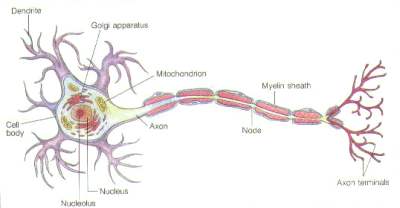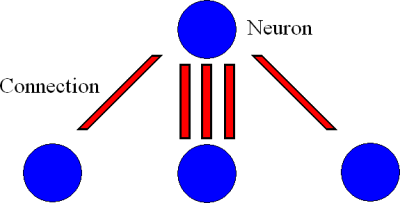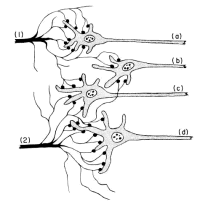
 |
 |
 |

 |
 |
 |

The purpose of our study was to create an accurate computer model of neural activity. We also wanted to use this project as a way to learn about neurons and to gain experience in programming.
At its greatest complexity our program could be used to study the properties of real neural interactions in a variety of situations.
The general function of the nervous system is to orchestrate the integration and communication of other body systems. These processes are accomplished by nerve impulses and are facilitated by neurons throughout the body. Neurons consist of four major parts, including the dendrites, which are responsible for receiving stimuli; the axon, which sends the nerve impulse away from the cell; the cell body, which is the site of metabolic activity in the cell; and the axon terminals, which connect neurons to other neurons, or neurons to other body structures. Each neuron can have several hundred axon terminals that attach to another neuron multiple times, attach to multiple neurons, or both.

We designed a basic program that could test the interaction of nerve impulses by changing and experimenting with variables. These variables include such factors as, the time it takes a neuron to return to resting potential, the threshold at which the neuron fires, the arrangement of such neurons in the human body, and how many inputs it takes for a neuron to fire.
At resting potential there is a specific ratio of sodium ions to potassium ions and anions diffusing in and out of the cell. When the neuron is resting, sodium is continuously pumped out of the cell, and the potassium and anions are pumped into the cell. The high concentration of positively charged sodium ions outside the cell, in comparison to the relatively negative charge inside the cell gives the membrane a potential of around 85 millivolts. When a neuron receives an electrical or chemical stimulus there is a sudden increase in the permeability of the membrane to sodium. The positive sodium ions rush in, reversing the membrane potential. Then the membrane again becomes almost completely impermeable to sodium and the normal resting potential is achieved. Unlike some simple simulations our model takes into account the time it takes a neuron to return to its resting potential. In addition our model can also experiment with the time that it takes for the membrane potential to reverse, both before it reaches the threshold level, and after it reaches the threshold level.
Next, a neuron must receive a certain amount of stimulus before the fiber is excited and the resting potential is reversed. Any stimulus below this level is called a subthreshold stimulus. Once the stimulus is past the threshold value the neuron fires the same way every time, no matter how much stimulus the neuron receives. In our simulation we can alter the amount of stimulus a neuron requires to pass the threshold value and fire.
Although there are many different ways that neurons connect to one another we chose to
experiment with neurons in a neuronal pool. Neuronal pools are found in the brain and spinal cord.
These neurons, each with many axon terminals, attach to the dendrites or cell bodies of as many as
several hundred other neurons. The area into which the endings of each incoming nerve fiber
spread is called its stimulatory field. Each input fiber is connected many times to neurons in the
center of its field and is connected fewer times to neurons in the outer edges of its field. Our model
takes this into account by connecting each neuron to the neuron directly in front of it three times
and the neurons on its periphery only once.


A neuron that receives only subthreshold stimuli can still fire in two ways. Convergence occurs when a neuron receives stimuli from two or more other neurons simultaneously and the total stimuli is enough to pass the threshold. This is demonstrated in figure I.3 when both fibers 1 and 2 are sending stimuli to neuron "c." Summation occurs when a neuron receives stimuli in quick succession from one or more neurons and the total stimuli is great enough to cause the permeability of sodium to increase and the resting potential to reverse. This is demonstrated in figure I.3 in a situation where both fibers 1 and 2 send stimuli and then either fiber fires again shortly after. In this case neuron "b" would receive enough stimuli to fire.